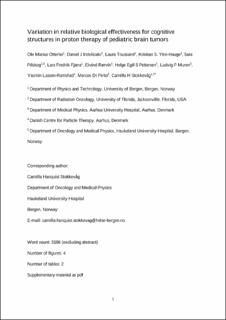| dc.contributor.author | Otterlei, Ole Marius | |
| dc.contributor.author | Indelicato, Daniel J. | |
| dc.contributor.author | Toussaint, Laura | |
| dc.contributor.author | Ytre-Hauge, Kristian | |
| dc.contributor.author | Pilskog, Sara | |
| dc.contributor.author | Fjæra, Lars Fredrik | |
| dc.contributor.author | Rørvik, Eivind | |
| dc.contributor.author | Pettersen, Helge Egil Seime | |
| dc.contributor.author | Muren, Ludvig Paul | |
| dc.contributor.author | Lassen-Ramshad, Yasmin | |
| dc.contributor.author | Di Pinto, Marcos | |
| dc.contributor.author | Stokkevåg, Camilla Hanquist | |
| dc.date.accessioned | 2021-07-01T10:52:12Z | |
| dc.date.available | 2021-07-01T10:52:12Z | |
| dc.date.created | 2020-11-18T19:47:29Z | |
| dc.date.issued | 2021 | |
| dc.Published | Acta Oncologica. 2020, 1-9. | |
| dc.identifier.issn | 0284-186X | |
| dc.identifier.uri | https://hdl.handle.net/11250/2762768 | |
| dc.description.abstract | Background
Clinically, a constant value of 1.1 is used for the relative biological effectiveness (RBE) of protons, whereas in vitro the RBE has been shown to vary depending on physical dose, tissue type, and linear energy transfer (LET). As the LET increases at the distal end of the proton beam, concerns exist for an elevated RBE in normal tissues. The aim of this study was therefore to investigate the heterogeneity of RBE to brain structures associated with cognition (BSCs) in pediatric suprasellar tumors.
Material and methods
Intensity-modulated proton therapy (IMPT) plans for 10 pediatric craniopharyngioma patients were re-calculated using 11 phenomenological and two plan-based variable RBE models. Based on LET, tissue dependence and number of data points used to fit the models, the three RBE models considered the most relevant for the studied endpoint were selected. Thirty BSCs were investigated in terms of RBE and dose/volume parameters.
Results
For a representative patient, the median (range) dose-weighted mean RBE (RBEd) across all BSCs from the plan-based models was among the lowest (1.09 (1.02–1.52) vs. the phenomenological models at 1.21 (0.78–2.24)). Omitting tissue dependency resulted in RBEd at 1.21 (1.04–2.24). Across all patients, the narrower RBE model selection gave median RBEd values from 1.22 to 1.30.
Conclusion
For all BSCs, there was a systematic model-dependent variation in RBEd, mirroring the uncertainty in biological effects of protons. According to a refined selection of in vitro models, the RBE variation across BSCs was in effect underestimated when using a fixed RBE of 1.1. | en_US |
| dc.language.iso | eng | en_US |
| dc.publisher | Taylor & Francis | en_US |
| dc.rights | Attribution-NonCommercial-NoDerivatives 4.0 Internasjonal | * |
| dc.rights.uri | http://creativecommons.org/licenses/by-nc-nd/4.0/deed.no | * |
| dc.title | Variation in relative biological effectiveness for cognitive structures in proton therapy of pediatric brain tumors | en_US |
| dc.type | Journal article | en_US |
| dc.type | Peer reviewed | en_US |
| dc.description.version | acceptedVersion | en_US |
| dc.rights.holder | Copyright 2020 Taylor & Francis | en_US |
| cristin.ispublished | true | |
| cristin.fulltext | postprint | |
| cristin.qualitycode | 1 | |
| dc.identifier.doi | 10.1080/0284186X.2020.1840626 | |
| dc.identifier.cristin | 1849534 | |
| dc.source.journal | Acta Oncologica | en_US |
| dc.source.pagenumber | 267-274 | en_US |
| dc.identifier.citation | Acta Oncologica. 2021, 60(2), 267-274 | en_US |
| dc.source.volume | 60 | en_US |
| dc.source.issue | 2 | en_US |

